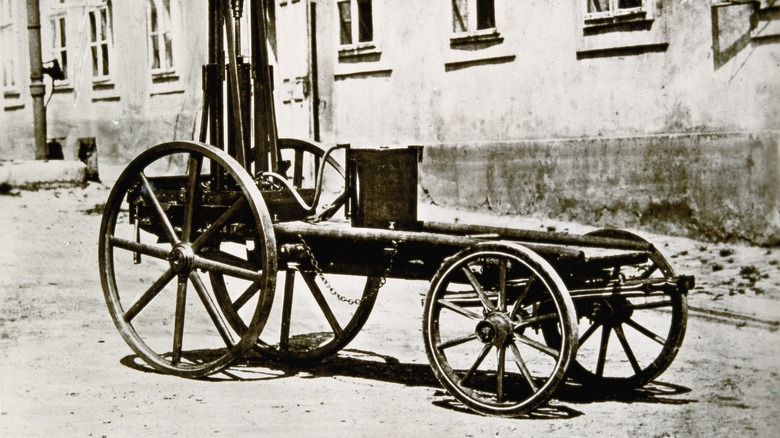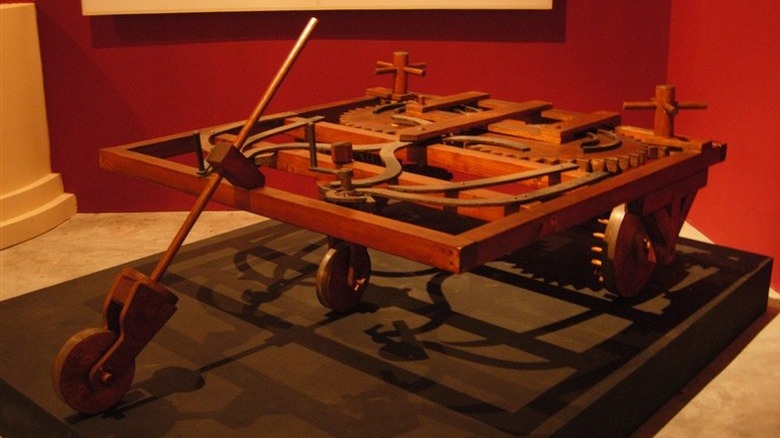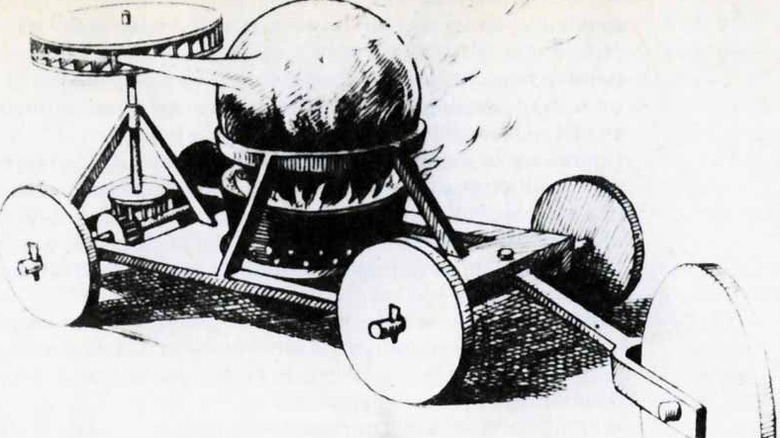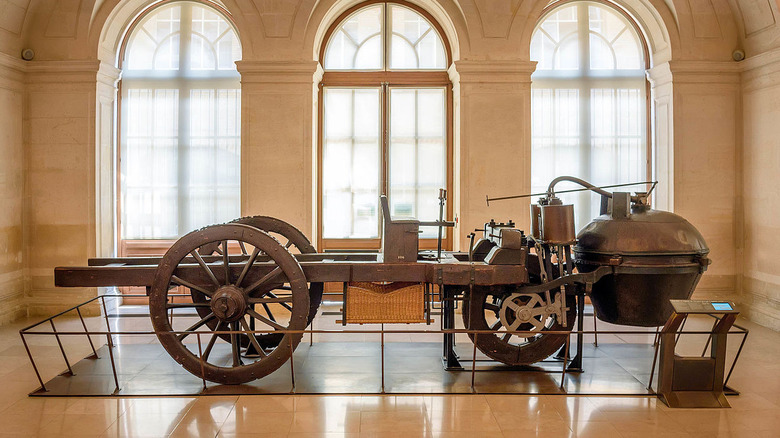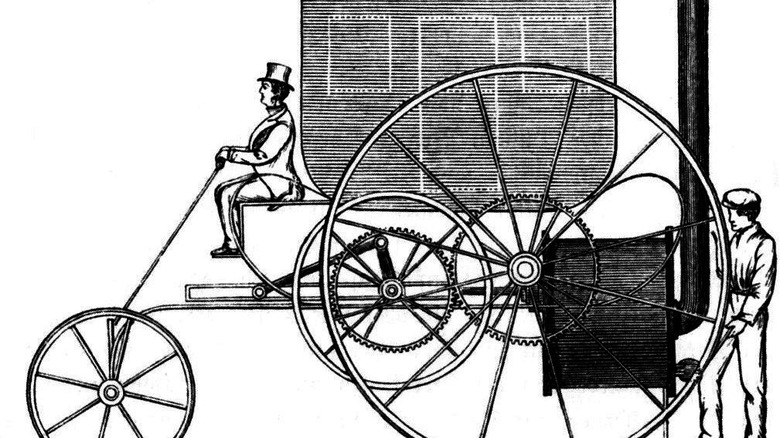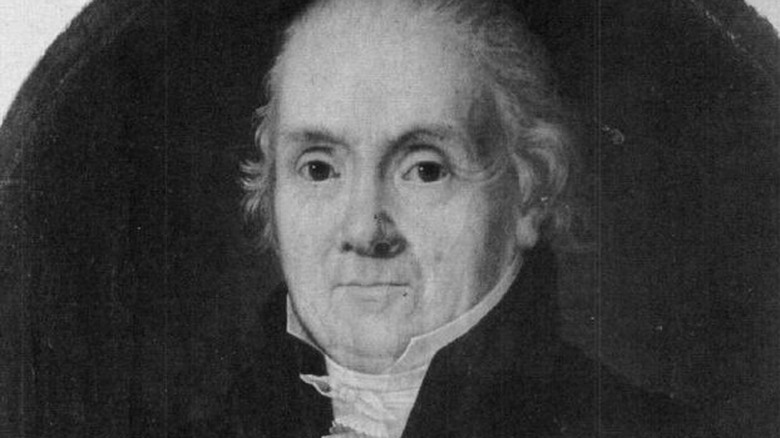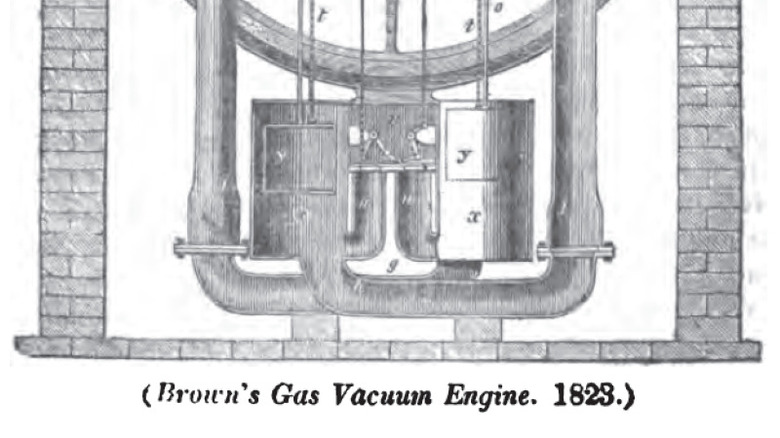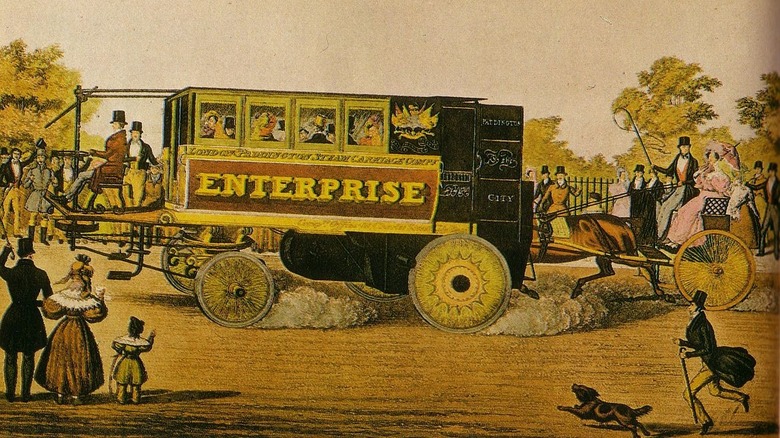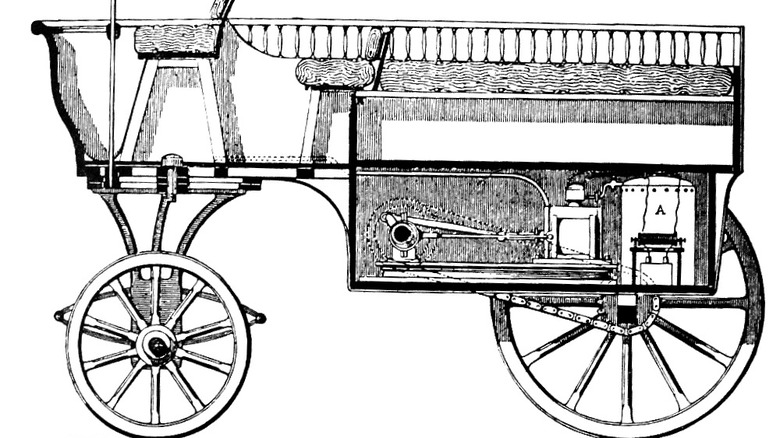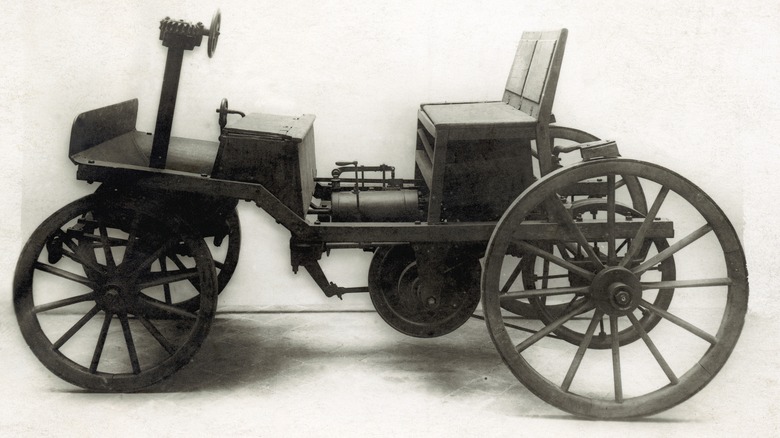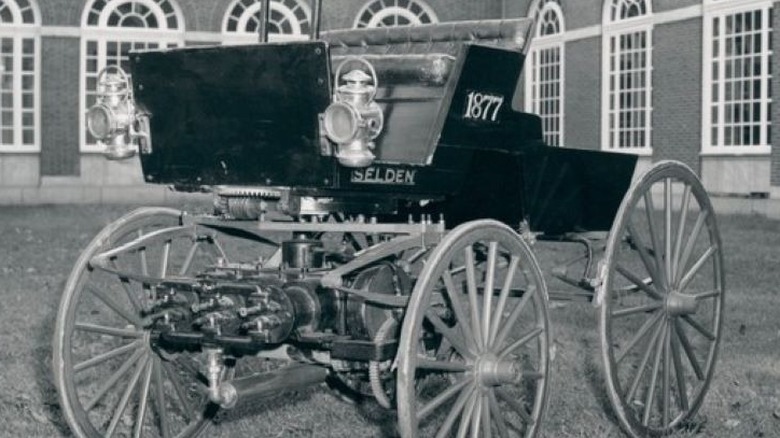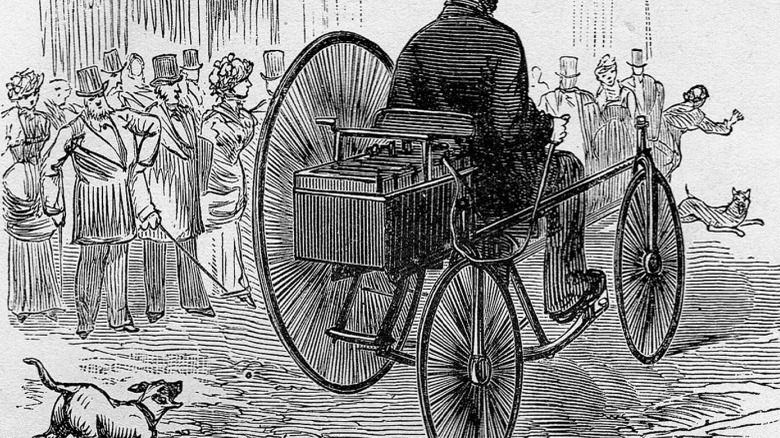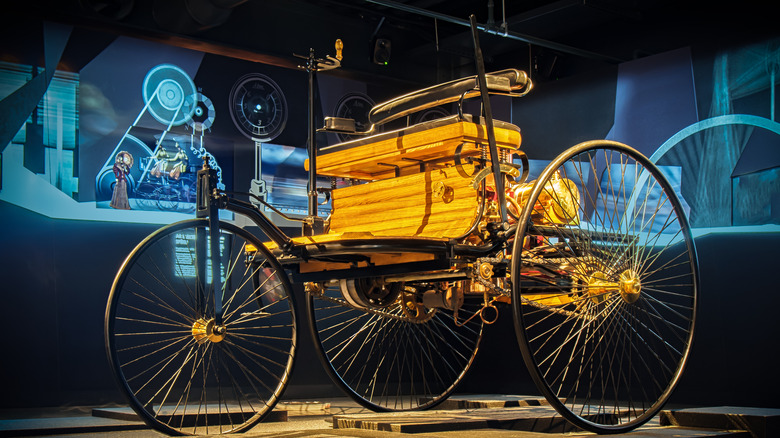The Secret History Of The First Car Ever Made
In her list of 10 world-changing inventions, the United States Librarian of Congress, Carla Hayden, ranked the automobile sixth (via National Geographic). Interestingly, readers of Scientific American from over 100 years ago held the mechanical marvel in similarly high regard. More than anything else, these attest to the game-changing nature of the car, an invention that has become so integral to everyday life that many would probably struggle to imagine how the modern world would be without it. People rely on it to travel, covering distances that would otherwise be inefficient or even impossible on foot. Many goods and services depend on automobile technology to reach faraway places in a safe and timely manner.
That said, the road towards the development and mass production of the car was not without bumps, potholes, and obstructions. Like countless technological innovations over the last few centuries, the automobile was certainly not born out of the genius of a single person. Instead, it was built upon the ideas of people working independently, all of whom had to work with the limitations of their time. Here are a few of the most significant milestones in the creation of the world's first car.
Mechanical 'horseless' carts and steam-powered carriage concepts
The idea of the modern automobile may not seem that impressive or groundbreaking now. After all, cars of different shapes, sizes, and colors are seen on major roads every day, and the resulting traffic has become a persistent pain in every city-dweller's side. However, there was a time when today's cars were barely formed in society's collective fantasies — and their predecessors were alive only in sketchbooks, stories, and scribbles.
According to the San Diego Automotive Museum, the development of the modern automobile was propelled by approximately 100,000 patents from different inventors working separately across the world. The world-renowned thinkers Sir Isaac Newton and Leonardo da Vinci are considered to be among the pioneers in conceptualizing motor vehicles, with da Vinci sketching a self-powered "horseless, mechanized cart" that he never managed to build while he was alive (via Live Science). His last residence, a manor house called the Château du Clos Lucé, features a replica of this invention built after da Vinci's time.
Before the dawn of today's automobiles, various inventors attempted to build vehicles powered by compressed air, springs, and even windmills (via the University of Houston). A noteworthy early take on the automobile was a steam-powered carriage called a "Fiery Chariot," conceptualized by physician Erasmus Darwin in a letter to engineer Matthew Boulton in 1764, per Jalopnik. While it was never actually built, some say it may have inspired others to work on steam-powered vehicles.
A Jesuit missionary's steam-powered toy car
Perhaps the earliest example of a verified functional steam-powered car was the one that Jesuit missionary and astronomer Ferdinand Verbiest created in 1672 (via Jalopnik). He even wrote about his creation in his book "Astronomia Europea," which serves as a descriptive record of this pioneering invention. There was just one catch: Verbiest didn't build it for people to actually ride in, as it was merely a plaything meant to help a monarch escape his own boredom.
Verbiest worked in the courts of the Chinese emperor K'ang Hsi in the mid-17th century (via Fairfield University). According to World Atlas, Verbiest initially relocated to China in fulfilment of his religious duties but eventually served the emperor as his astronomer. Verbiest's tasks mainly involved developing astronomical instruments and calendars. However, his creativity and imagination also helped him build what would become a milestone in car history: a 2-foot-long, self-propelled, five-wheeled cart.
As explained by Jalopnik, Verbiest's cart had a ball-shaped steam generator (boiler) that was designed to shoot steam towards the vanes of its rear wheels. When water was heated in the vessel, the steam ejected by its nozzle effectively pushed the cart via a gear system, making it the world's earliest recorded self-propelled car. While it certainly wasn't designed with the possibility of carrying passengers in mind, it is no less significant in establishing that the concept of self-propelled vehicles was indeed feasible.
The first motor vehicle accident
When asked about the inventor of the first "true" automobile, many would likely point to French military engineer Nicolas-Joseph Cugnot and his "steam dray." Cugnot designed and built this "almost-usable automobile" in 1769, and even built a second one two years later (via Jalopnik).
What set Cugnot's efforts apart from previous inventors was the fact that earlier attempts focused on using steam pistons. Cugnot, on the other hand, took things a step further by incorporating a ratchet into the mechanism, enabling the piston to generate enough rotational power to propel the vehicle, according to MotorBiscuit. This was necessary, as Cugnot designed his steam-powered cart to move military weapons and supplies from one location to another via land. Unsurprisingly, this made Cugnot's steam dray incredibly heavy (about 2.5 tons) and tremendously sluggish. Achieving only an average speed of approximately 2.25 mph, it allegedly had to take a break after 20 minutes of operation, in order for it to generate enough steam to propel itself for another round (per Live Science).
Interestingly, Cugnot's mechanical marvel, which was absolutely not designed for passengers, immortalized the inventor's name in a different (and rather embarrassing) way. In 1771, Cugnot accidentally hit a stone wall, partly due to the automobile's inefficient, front-heavy weight distribution. When Cugnot lost funding for subsequent projects due to the loss of his clients, the development of his motor vehicles came to a screeching halt (via the San Diego Automotive Museum).
The first steam-powered passenger-carrying vehicle
On December 24, 1801, English engineer and inventor Richard Trevithick operated a steam-powered road locomotive, carrying seven other passengers (via History). Trevithick's invention was given the somewhat ominous nickname "Puffing Devil," but this didn't dissuade his friends from hopping aboard. Which was fortunate, given how Trevithick's attempts at steam-powered transportation would end up greatly influencing the development of today's cars.
According to The Brooklands Society, Trevithick and his seven acquaintances rode his steam-powered locomotive up a hill for several hundred yards. Sadly, Trevithick's machine was damaged beyond repair in a freak accident, when it suddenly set its own shed ablaze while the inventor and his friends were celebrating their successful test run. However, Trevithick was undaunted — and two years later, he built another carriage at Felton's carriage works in London.
The so-called "London Steam Carriage" became not only the first self-powered passenger-carrying road vehicle in the world but also the first self-powered vehicle to travel through London's streets (via London Remembers). Despite its success, however, work on the London Steam Carriage was eventually discontinued for two reasons: It was simply too expensive to become a feasible transportation option, and it required too much effort to operate. Or, as The Brooklands Society put it, "it needed two men and a bag of coal to do what a horse drawn vehicle could do with one man and a bag of hay."
The first car with an internal combustion engine?
A crucial detail about attempts at perfecting the automobile prior to the 1800s was that none of them had an engine designed for internal combustion. Steam-powered vehicles are equipped with external combustion engines, which require heating liquid and relying on the resulting gas for propulsion (per MotorBiscuit). At some point, inventors realized that they should start further exploring the idea of internal combustion — "an explosion that creates enough expanding gas [that] it can build pressure on its own" — but they didn't know what they could use as a source of fuel.
Enter French-born Swiss politician and tinkerer Francois Isaac de Rivaz, who was quite familiar with steam-powered engines. Opting to mix hydrogen and oxygen as his fuel source, Rivaz came up with an internal combustion engine, which he added to a car in 1808 (via World Atlas). Unfortunately for Rivaz, his automobile idea didn't quite catch on with the public. Eventually, development on it was scrapped. Nevertheless, many historians consider Rivaz's car to be the world's first automobile powered by internal combustion.
That said, Rivaz was far from the first person to come up with the idea of an internal combustion engine. According to National Geographic, Dutch scientist Christiaan Huygens came up with an internal combustion engine concept near the end of the 17th century, which used gunpowder as its power source. Unsurprisingly, this turned out to be too dangerous for widespread adoption (via Ripley's).
Pioneering the gas engine (and car companies, too)
According to the University of Houston, identifying the inventor of the first true automobile is not as straightforward as it may seem. Slightly less complicated, however, is the quest to find the first person to successfully create a car powered by a gasoline-burning internal combustion engine. While Samuel Brown was certainly not the inventor of the internal combustion engine, he has been called by some experts and historians as the developer of "the first gas engine that unquestionably did actual work and was a mechanical success," as per the "Survey of London" (via British History Online).
From 1825 to 1835, Brown stayed at Eagle Lodge in west London, where he worked on his engine concepts. In 1826, the English cooper tweaked the inner workings of an old steam engine, enabling it to burn gasoline. He then put it inside his car and used it to drive up Shooter's Hill.
Curiously, at around the same time Brown was experimenting with gasoline-powered engines, another English pioneer was taking steam-powered road vehicles in a different direction (per AutoWeek). Inventor Goldsworthy Gurney established the Gurney Steam Carriage Company, which some experts recognize as the world's first automobile company. However, his goal to make steam-powered road vehicles more popular with the public ultimately failed, possibly due to the population's hesitation to embrace new technology and the comparatively exorbitant cost of operating such vehicles at the time.
The first commercially manufactured steam-powered car
An important milestone in the evolution of the automobile came in the early 1830s, and it was a product from the mind of a watchmaker named Walter Hancock.
As Nature details, after receiving a patent for his own steam generator design, Hancock assembled two different steam carriages. The second carriage, which he named the Infant, became operational in February 1831, traveling between London and Stratford. The London and Paddington Steam-Carriage Co. was established in 1833, and under its banner, Hancock created a steam-powered omnibus called Enterprise. Capable of fitting 14 passengers, Enterprise became the first-ever mechanically propelled omnibus to become fully operational on April 22, 1833. Its 10-mile route covered the area between Paddington and Moorgate, a journey that took less than an hour for the omnibus to complete.
Unfortunately, due to problems behind the scenes between the inventor and the carriage company, the service was discontinued after two weeks and two days. Hancock's involvement in steam-powered transportation didn't end there, however, as his other steam vehicles started operating once more in 1836. Hancock's vehicles had reportedly carried 12,761 passengers across 4,200 miles within a five-month period. Based on numbers presented by the Virtual Steam Car Museum, Hancock may have built up to 10 steam-powered vehicles from 1824 to 1842.
A three-wheeled wagon running on coal gas
Nicolas-Joseph Cugnot's groundbreaking attempts at creating a reliable steam-powered vehicle ended up becoming an engineer's inspiration for the next phase in the automobile's evolution, over a century later. However, it was not just Cugnot's successes that pushed Belgian-French inventor Jean Joseph-Etienne Lenoir to work on his own project, but Cugnot's failures as well.
According to The Motor Museum in Miniature, Lenoir had been reading the stories of Cugnot's automobile in 1851 and was equally fascinated and horrified by the vehicle and the accidents it got into. Allegedly, Lenoir remarked, "Surely there is a better way, let's see about this goblin." Lenoir then proceeded to conduct various trials and experiments over the years, culminating in a major breakthrough in 1858. Lenoir successfully created and patented a "double-acting, electric spark-ignition internal combustion engine fueled by coal gas" (per Live Science).
By the early 1860s, he reportedly equipped a three-wheel wagon with his engine, and managed to cover a 50-mile distance. This experimental car featured a pre-compression system and even a handbrake, with the driver's seat positioned near its cooling water tank. Eventually, Lenoir's internal combustion engine became widely regarded as the first practical, reliable, and sufficiently available engine of its kind. Based on available descriptions and reports about Lenoir's vehicles, he is said to have built an "almost practical" internal-combustion engine automobile that could travel as fast as 1.86 mph.
The first petrol-propelled vehicle
According to World Atlas, Jewish inventor Siegfried Marcus built the world's first gasoline-powered combustion engine. He is also credited with having built the oldest known surviving automobile on the planet (via The American Society of Mechanical Engineers). Interestingly, this historic vehicle was the second of what may have been four cars that Marcus built in his lifetime.
Marcus had actually built his first car years earlier. Allegedly, it was a pushcart equipped with a two-cycle combustion engine. Experts say that he dismantled his creation after deeming it unusable on the road. Historians are unsure as to the exact year when Marcus built his second automobile, which is noteworthy for having a four-cycle engine and being the first car to run on gasoline.
Marcus' second car, speculated to have been constructed in 1875, was described as an "experimental" vehicle. While it was never mass-produced, it allegedly did a brief demonstration run across Vienna. The car is now in the possession of the Austrian Automobile, Motorcycle, and Touring Club in Vienna, with the Vienna Technical Museum serving as its home. He may have also built a third and fourth car, both of which met the same fate as the first. Curiously, the University of Houston revealed that in his later years, Marcus didn't have much faith in the automobile, calling the concept "a senseless waste of time and effort."
The first 'safe and practical' oil engine
Per Live Science, an American engineer named George Brayton developed what many would call the world's first "safe and practical oil engine." Unfortunately, safety and practicality don't guarantee success, a lesson that Brayton would end up learning the hard way.
According to Gas Engine Magazine, Brayton was able to commercially release the Brayton cycle engine, a two-stroke system that used kerosene, in 1872. For reference, the four-stroke design patented by German engineer Nicolaus Otto came out five years later. Despite relying on a compressed fuel/air charge for ignition, Brayton's engine had one key difference from Otto's: Instead of compressing the charge in its combustion cylinder, it used a pumping piston in a separate cylinder. The compressed fuel/air charge would then be transferred to the combustion cylinder, which would in turn move a crank by driving a beam via a different piston. It was a system that worked, but in a way that wasn't nearly as efficient as Otto's engine.
Ultimately, Otto's engine emerged as the superior option, and despite Brayton's best efforts to dominate the market, 1890 marked the last year he would be issued a patent for his engines.
The first rechargeable electric car
With modern-day companies touting the electric car concept as the next step for automobiles, many people tend to think that a car that runs on an electric battery is such a futuristic idea. Which is ironic, given how the electric car actually emerged years before the present-day automobile did.
The Connexion attributes the creation of the first electric vehicle in the world to Gustave Trouvé, a French inventor. Trouvé was a prolific maker, registering at least 300 patents in his lifetime for a wide assortment of inventions. Among his most noteworthy creations were the metal detector, the electric razor, the dental drill used by professionals today, an early version of the endoscope, a headlamp, and a portable slide projector. Many of these inventions were made possible when Trouvé unlocked the key to lightweight rechargeable batteries. In 1881, Trouvé took this concept and applied it to transportation, hooking up his rechargeable battery and an electric motor to a British tricycle that he reportedly rode around Paris (via MotorBiscuit).
Unfortunately, Trouvé was not granted a patent for his electric tricycle, due to the steam-powered version already existing. As a result, he took his battery-powered motor technology and tweaked it to work on boats, creating the outboard motor in the process.
The first patented 'true, modern' automobile
With the sheer number of inventors and innovators working on the automobile within the same time frame, the distinction of creating the first true modern automobile could have easily gone to anyone. However, it was ultimately Karl Benz who obtained the patent for what would come to be known as the world's first practical car (via World Atlas).
Benz successfully patented his "Motorwagen," a three-wheeled carriage equipped with an internal combustion engine, on January 29, 1886. Benz's Motorwagen featured an engine that he also held the patent for, said to be the first engine of its kind to nail gasoline-powered internal combustion (per MotorBiscuit). The engine was able to generate approximately 0.75 horsepower and weighed 220 pounds. According to Live Science, Benz also held patents for spark plugs, a water radiator, gear shifters, a carburetor, and even a throttle system of his own design.
Two years later, Benz started to mass-produce his automobile. The evolution of the automobile didn't stop here, though. Many other improvements to the technology emerged in subsequent years, including Gottlieb Wilhelm Daimler and Wilhelm Maybach's four-wheeled Cannstatt-Daimler and Charles and Frank Duryea's first truly successful gas-powered car (per the Library of Congress).
